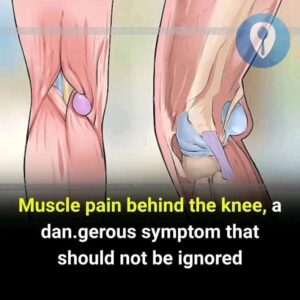Muscle pain behind the knee is a complaint many people experience at some point in their lives.
While it is often dismissed as a minor issue related to fatigue, overexertion, or aging, pain in this area can sometimes signal a more serious underlying condition.
Ignoring persistent or severe discomfort may delay proper diagnosis and treatment, potentially leading to long-term complications.

Common Causes of Pain Behind the Knee
There are several possible reasons for muscle pain in this region, ranging from simple to severe:
-
Muscle Strain or Overuse
-
Intense exercise, prolonged walking, or sudden movements can strain the hamstring or calf muscles.
-
This type of pain usually improves with rest, ice, and stretching.
-
-
Tendon and Ligament Injuries
-
Injuries to the posterior cruciate ligament (PCL) or hamstring tendons can cause localized pain.
-
These injuries are often the result of sports, accidents, or sudden twisting of the knee.
-
-
Baker’s Cyst (Popliteal Cyst)
-
A fluid-filled swelling behind the knee that can cause pressure and aching.
-
It is often linked to arthritis or meniscus tears.
-
-
Deep Vein Thrombosis (DVT) – A Serious Concern
-
One of the most dangerous causes of pain behind the knee is a blood clot in the deep veins of the leg.
-
Symptoms may include swelling, redness, warmth, and tenderness. If left untreated, the clot can travel to the lungs, causing a life-threatening pulmonary embolism.
-
-
Osteoarthritis and Degenerative Changes
-
Wear and tear in the knee joint can cause pain that radiates behind the knee.
-
Stiffness, reduced mobility, and occasional swelling are common associated symptoms.
-
Warning Signs That Require Medical Attention
Although mild muscle pain behind the knee is usually harmless, certain warning signs should never be ignored:
-
Sudden, sharp, or severe pain that does not improve with rest.
-
Swelling, warmth, or redness in the calf or behind the knee.
-
Difficulty bearing weight or walking.
-
Numbness, tingling, or a feeling of weakness in the leg.
-
Persistent pain lasting more than a week without improvement.
Diagnosis and Treatment
If you experience concerning symptoms, a healthcare professional will likely perform a physical examination, medical history review, and imaging tests such as ultrasound or MRI to determine the exact cause.
Treatment depends on the underlying condition:
-
For muscle strain: Rest, ice, compression, elevation (RICE), and gentle stretching.
-
For ligament or tendon injuries: Physiotherapy, bracing, or in severe cases, surgery.
-
For Baker’s cyst: Addressing the root cause such as arthritis or meniscus injury.
-
For DVT: Immediate anticoagulant medication to prevent complications.
Prevention Tips
-
Warm up before exercise and cool down afterward.
-
Maintain a healthy weight to reduce stress on the knees.
-
Stay physically active but avoid overexertion.
-
Stay hydrated and take breaks during long periods of sitting or standing.
Conclusion
Muscle pain behind the knee should never be ignored, especially when accompanied by swelling, redness, or sudden discomfort. While in many cases the cause may be minor, this symptom can also indicate serious medical conditions such as deep vein thrombosis or structural knee injuries. Early medical evaluation and treatment are essential to ensure recovery and prevent complications.





